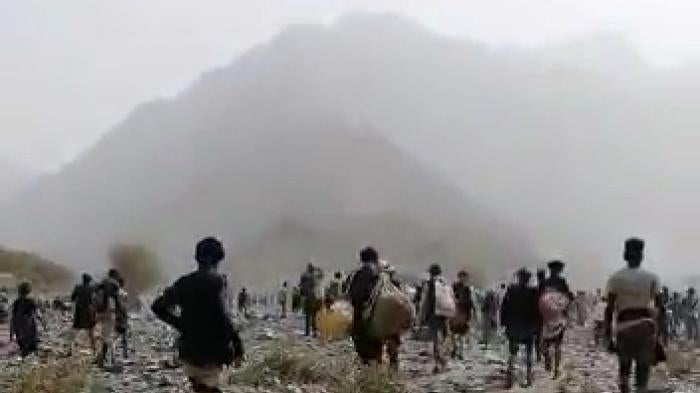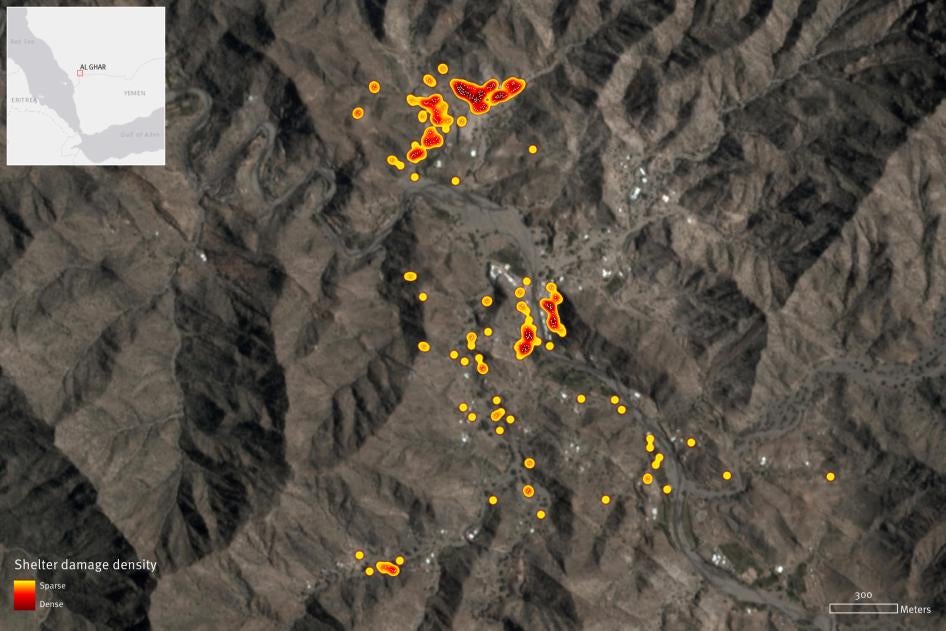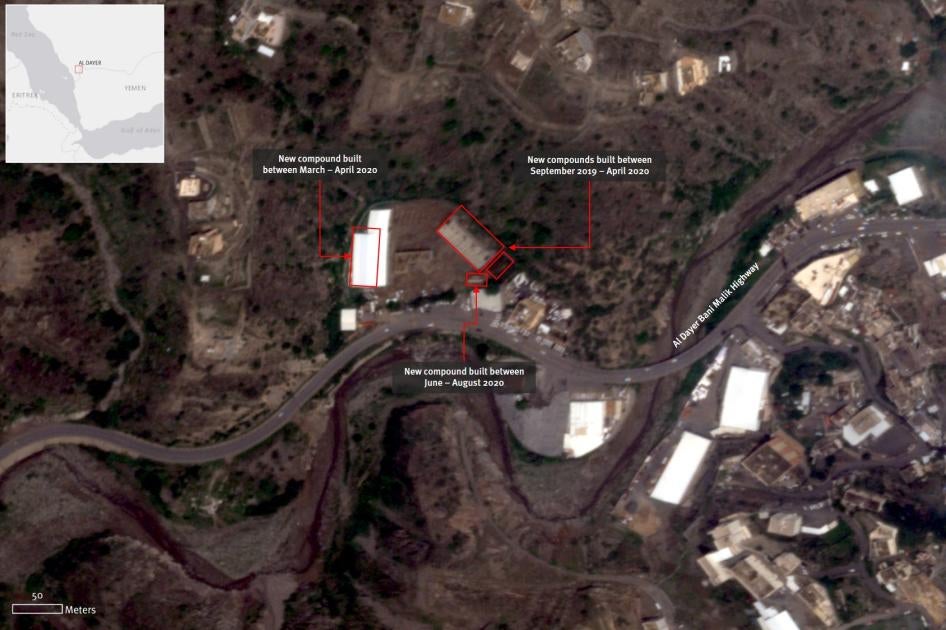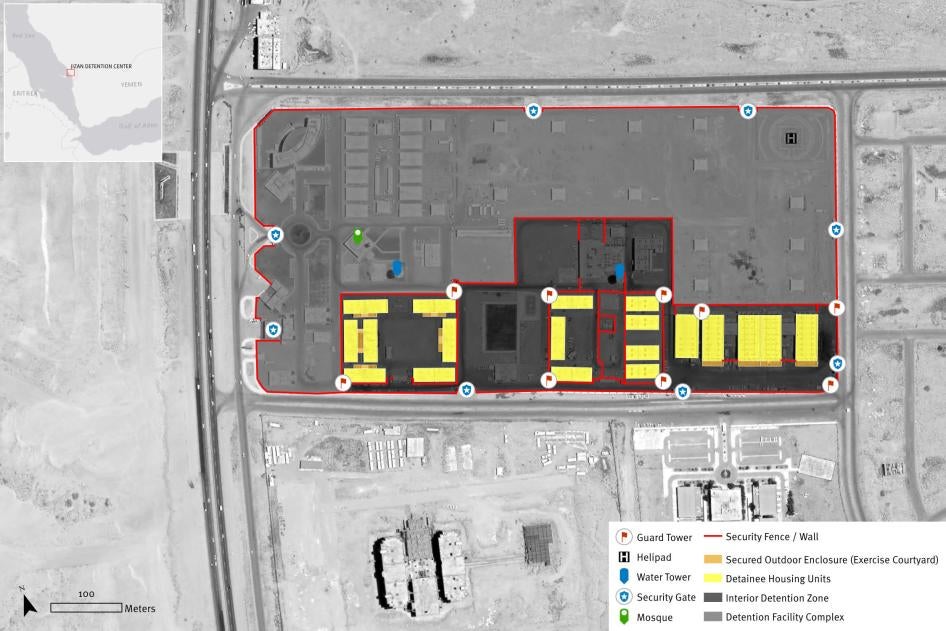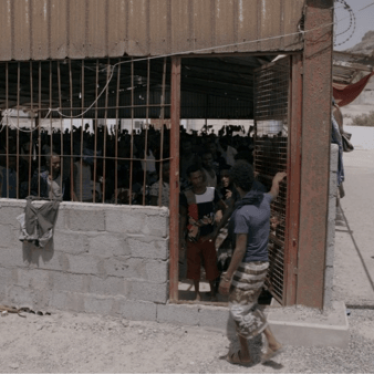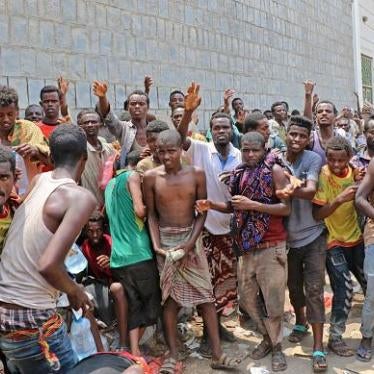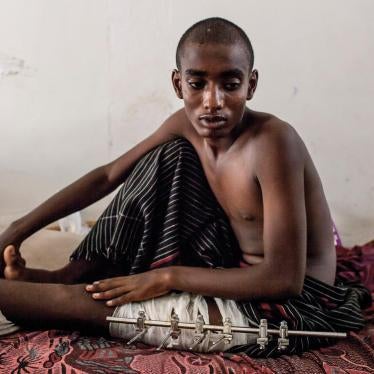(Beirut) – Houthi forces in April 2020 forcibly expelled thousands of Ethiopian migrants from northern Yemen using Covid-19 as a pretext, killing dozens and forcing them to the Saudi border, Human Rights Watch said today. Saudi border guards then fired on the fleeing migrants, killing dozens more, while hundreds of survivors escaped to a mountainous border area.
Ethiopian migrants told Human Rights Watch that after they spent days stranded without food or water, Saudi officials allowed hundreds to enter the country, but then arbitrarily detained them in unsanitary and abusive facilities without the ability to legally challenge their detention or eventual deportation to Ethiopia. Hundreds of others, including children, may still be stranded in the mountainous border region.
“The lethal disregard Houthi and Saudi forces have shown civilians during Yemen’s armed conflict was replayed in April with Ethiopian migrants at the Yemen-Saudi border,” said Nadia Hardman, refugee and migrant rights researcher at Human Rights Watch. “United Nations agencies need to step in to address the immediate threats to the Ethiopian migrants and press for accountability for those responsible for the killings and other abuses.”
In June and July, Human Rights Watch interviewed 19 Ethiopian migrants, including 13 men, 4 women, and 2 girls, currently in Saudi Arabia or Ethiopia. The Houthi armed group, which took over the capital, Sanaa, in September 2014 in an armed conflict that a Saudi-led coalition joined in March 2015, have for many years controlled Yemen’s northwest border areas.
Migrants told Human Rights Watch that on or about April 16, Houthi fighters in green military uniforms brutally rounded up thousands of Ethiopians in al-Ghar, an unofficial migrant settlement area in Saada governorate. The Houthi forces, who were regularly seen patrolling the area, forced the migrants into pickup trucks and drove them to the Saudi border, firing small arms and light weapons anyone who tried to flee.
Witnesses said that Houthi fighters screamed that the migrants were “coronavirus carriers” and had to leave al-Ghar within hours. “They [Houthi forces] created chaos,” said an Ethiopian woman. “It was early in the morning [on April 16] and they told us to leave in two hours. Most people left, but I stayed. But after two hours, they started firing bullets and rockets – I saw two people killed.”
Another woman, who was pregnant and traveling with her young child, said the Houthi forces were using “rockets” to clear the area: “There were lots of Houthi soldiers. There were more than 50 trucks. They were firing a mortar which you put on the ground and it fires. Everyone started to run to escape. I ran with a group of 45 people – and 40 people were killed in my group. Only five of us escaped. They were not firing guns, just these mortars.”
Twelve of the migrants interviewed witnessed killings of migrants or saw their bodies, but the number killed could not be determined. Migrants who managed to return to al-Ghar found their tent settlement and surroundings destroyed. Human Rights Watch reviewed satellite imagery recorded immediately before, during, and after the alleged attack, and observed widespread destruction of over 300 tents and houses consistent with witness accounts.
Once migrants approached within one to two hundred meters of the border, Saudi border guards in gray and tan uniforms started firing at them with what witnesses described as mortar shells and rocket launchers. They said that Houthi forces responded by firing at the Saudi border guards and at any migrants who tried to escape from the chaos of the fighting back into Yemen.
Many migrants managed to escape to a riverbed near the mountains where they sheltered for up to five nights. People interviewed described hearing gunshots for at least two days. Eventually they either surrendered or Saudi border guards found them. The border guards took them to what the migrants described as a “military camp” 15 minutes travel from the Saudi border where they were held for several hours. Human Rights Watch used satellite imagery to identify several possible Saudi military compounds positioned on hilltops overlooking the Yemeni border, consistent with location(s) described by witnesses from which Saudi forces fired at them.
Eight migrants said the border guards took their money, extra clothes, and other belongings. The border guards then separated men and women, including families, and transported them over the next few days in small cars and pickup trucks to a detention facility in al-Dayer, a governorate of Jizan province in southwest Saudi Arabia. From there the migrants were taken to other detention facilities in Jizan and Jeddah.
Using satellite imagery, geospatial datasets and witness accounts, Human Rights Watch identified two complexes in al-Dayer and Jizan, the provincial capital, which appear to be the facilities holding Ethiopian migrants.
Human Rights Watch interviewed six Ethiopian men currently detained in Jizan, a woman at the Shmeisi Detention Center east of Jeddah, and six Ethiopian women and girls recently deported back to Ethiopia at a quarantine center in Addis Ababa. All were detained first in al-Dayer and then in a detention center in Jizan.
They uniformly described poor detention conditions including overcrowding, blocked and overflowing toilets, lack of beds and blankets, lack of medical care including prenatal care for those who were pregnant, inadequate food and water, and poor toilet facilities. They described serious skin problems they said were caused by the unhygienic conditions. Three men said that guards beat them for complaining about the conditions. Photo images and videos of detainees in al-Dayer and a detention center in Jizan corroborated the witness accounts, including a video showing hundreds of women crowded together in ankle-deep dirty water screaming and crying.
Houthi authorities should investigate and appropriately punish commanders and fighters responsible for the killing, forcible expulsion, and other abuses against Ethiopian migrants in the vicinity of al-Ghar.
The Saudi government should investigate and fairly prosecute border guard officials responsible for unlawfully firing on Ethiopian migrants near the border area. Saudi authorities should also end the arbitrary and abusive detention of thousands of Ethiopian migrants. In the interim, it should release children and pregnant and nursing women and should immediately improve conditions in detention centers. Immigration detention should be applied as an exceptional measure of last resort, for the shortest period, and only if justified by a legitimate purpose. Children should never be detained for migration-related reasons.
“Hundreds if not thousands of Ethiopian migrants are now languishing in squalid detention centers in Saudi Arabia or remain stranded at the border,” Hardman said. “The United Nations needs to work with the Saudis and Ethiopians to assist in the voluntary return of Ethiopians in detention or still stranded at the border.”
Ethiopian Migration Route to Saudi Arabia
An unpublished 2019 study found that over 90 percent of migrants passing through Yemen come from Ethiopia. A combination of factors, including economic difficulties, drought, and human rights abuses have driven hundreds of thousands of Ethiopians to migrate over the past decade, mostly traveling irregularly by boat over the Red Sea and then by land through Yemen to Saudi Arabia. The International Organization for Migration (IOM) estimated that nearly 140,000 migrants arrived in Yemen in 2019. In 2019, Human Rights Watch documented a network of smugglers, traffickers, and authorities in Yemen that kidnap, detain, and beat Ethiopian migrants and extort them or their families for money.
Migrants who illegally cross into Saudi Arabia usually do so in the mountainous border area separating Yemen’s Saada governorate and Saudi Arabia’s Jizan province. Many are apprehended crossing the border or within the country’s interior. About 260,000 Ethiopians, an average of 10,000 per month, were deported from Saudi Arabia to Ethiopia between May 2017 and March 2019, according to IOM.
Human Rights Watch has previously documented the perilous journey migrants undertake from the Horn of Africa to Yemen and Saudi Arabia as well as the horrific treatment and abuses against them by parties to the conflict in Yemen. In 2017, an apparent Saudi-led coalition attack on a boat carrying Somali civilians off the coast of Yemen killed at least 32 Somali migrants and refugees aboard and one Yemeni civilian, in violation of the laws of war. In 2018, Human Rights Watch found that Yemeni government officials had tortured, raped, and executed migrants and asylum seekers from the Horn of Africa in a detention center in the southern port city of Aden.
April Clearance Operations in al-Ghar
People interviewed said that they were collectively expelled from al-Ghar on or around April 16. The town is about two kilometers from the border in Saudi Arabia, and Human Rights Watch located it through satellite imagery, geospatial data, ground photos, and videos.
Interviewees described the Houthi operation that cleared them from the town. “Juhur” (all names are pseudonyms for their protection) has not seen his wife since that day:
We were shocked, and it was really terrible. One reason the soldiers gave [for us to leave] is because of corona. They said you need to move out of the town and you are not here to stay – you are just passing through. The people [living] in al-Ghar were in the thousands. I am afraid I lost my wife there. My mind is really broken now. The Houthis were shooting at us. The Houthis came with military cars, like pickups – they were using weapons. There were very many soldiers, but I don’t know how many. Everyone ran for their lives.
An Ethiopian man who was working in a health facility in Saada governorate in mid-April said:
It was one week before Ramadan. I saw eight people brought in severely injured. Two had lost their legs. They came in with Houthi soldiers. The medical doctors were saying, “Refer them to another hospital.” But the soldiers didn’t want to help them. The people were screaming for water. The injured were saying, “We can survive,” but they were talking in Oromo [an Ethiopian language]. They [the Houthi forces] told them, “These people have corona, and their life doesn’t matter, they should die and they should not tell the truth about what happened to them.” I speak fluent Arabic, which is how I know what they were saying. They were received in an emergency room but after that they were taken to the morgue. They had all died.
Houthi fighters forced everyone to the border with Saudi Arabia. “Gabi” said:
The Houthis were pushing us from behind. We tried to run in front of them but in front of us there was a mountain. There were people shooting from the top of the mountain, from the Saudi base and they were firing on us from there and they were firing behind, from the Houthi side, so we stayed in between the mountains. They were firing bullets behind us and then from the Saudi base they were firing too and so a lot of people were injured and killed.
Juhur said, “The Houthis pushed us to where the Saudi soldier base is located. That is when they [the Houthis] stopped behind.” He said that the Saudis fired at them for two hours close to the Saudi military base. “It all happened within a few hours,” he said. “The Saudis were firing a rocket launcher at us. I saw people shot and killed and they rolled over on the ground.”
“Abiy” said that Saudi border guards fired on the migrants: “I could see the Saudis, they had really big guns with them. It looked like a mortar. Two or three people were standing around the weapons … They started shooting when numbers of people started increasing. I was with 150 people when they started shooting at us. Nobody was saying anything, they spoke through their weapons. If people moved, they fired.”
People interviewed said they escaped to a nearby riverbed in the mountains.
“Abiy,” who spent three days in the mountains before returning to al-Ghar, found the migrant settlement destroyed: “I tried to go back to al-Ghar, but I saw they destroyed al-Ghar. Not only the migrant area but also Yemeni houses; most [of these] houses were made from brick.”
Human Rights Watch analysis of satellite imagery confirmed that the demolition of shelters in al-Ghar started on or around April 17, continued through April 19, and ended around April 22 with approximately 300 structures destroyed.
Human Rights Watch received and analyzed videos from interviewees that depict hundreds of people in the mountains between Yemen and Saudi Arabia in mid-April. People either stayed there and eventually surrendered to the Saudi border guards or border guards intercepted them and allowed them to enter Saudi Arabia. Human Rights Watch also spoke to five men who managed to hide and then make their way back to Sanaa.
A June 28 New York Times article said that an estimated 7,000 migrants were still believed to be stranded at the border between Yemen and Saudi Arabia. One migrant stranded at the border on July 16 confirmed that about 600 migrants – many of them women and children – remained stranded at that time, approximately 10 kilometers from al-Ghar, with limited access to food and water, surviving only on handouts from local Yemenis who live in the mountainous region.
Detention in Saudi Arabia
The detention of migrants in deplorable facilities in Saudi Arabia is a longstanding problem. In 2014, a Human Rights Watch report on the trafficking of migrants transiting to and inside Saudi Arabia documented the use of a deportation center near Jizan. In 2019, Human Rights Watch identified approximately 10 prisons and detention centers where migrants were held for various periods. The three most frequently cited were Jizan Central Prison in Jizan city, the Shmeisi Detention Center east of Jeddah, where migrants are processed for deportation, and a center near the town of al-Dayer in Jizan province along the border. Locations in Jizan, al-Dayer, and Jeddah were cited by migrants interviewed for this report.
People interviewed described being taken in small cars and pickup trucks from the Saudi border to a detention facility in al-Dayer, where prison guards wore the same gray and tan uniforms as Saudi border guards. Human Rights Watch identified a prison complex in al-Dayer that matched the descriptions of those interviewed.
“Abiy” described conditions at al-Dayer:
It is better to die than to live there [at al-Dayer]. It is so overcrowded.… There was no space. All women and men were held together for a night and the next day they separated us. I was in Dayer for seven days. They say they provide food three times a day but at lunchtime, they bring a small plate of rice and you have to sit with 10 people and just eat a spoon of rice from that plate.…In the morning we had a slice of dry bread and at night the same thing. There is no water – but to keep us alive, they opened the handwashing pipe in the toilet for 30 minutes to drink from. The toilet was full – so we used one side of the room as a toilet – and another side we lived in.
Human Rights Watch spoke to women and girls who estimated that, after they were separated from the men, 300 to 500 of them were held in one room in severely overcrowded conditions. Human Rights Watch reviewed video footage sent by a person held in al-Dayer that depicts hundreds of women under a wire mesh roof, ankle deep in filthy water, screaming and crying. “Rishan,” who was held in al-Dayer for 26 days with her year-old child, said:
The situation was so bad. The room was so small, there is no toilet and there was no roof. The temperature was so high and there was a bad smell because of the toilet situation.… They [the soldiers] did not speak to us. If we said someone is going to die, they wouldn’t do anything.… Three women tried to give birth during prison – they took them to the hospital but unfortunately one woman didn’t come back with a baby. She was psychotic when she came back. They kept her for a while in Dayer and now she is in Jeddah…. I stayed in Dayer for 26 days.…I was crying because my child was very sick. I was crying to take my child to the hospital.
Women and girls said their situation generally improved when they were taken to a detention facility in Jizan. Human Rights Watch analyzed satellite imagery together with witness accounts and found a complex in Jizan city whose layout and security features (including internal walls and fences, guard towers, secured outdoor enclosures, and helipad) are consistent with a migrant detention facility or prison. Human Rights Watch believes this is the detention facility where Ethiopian migrants are currently being detained.
For men, the conditions deteriorated when they got to Jizan. “Desta” said:
In one room there are 400 people with me. The area of the place is approximately 150 square meters, maybe not more than 200 meters. They give us three small bread pieces and one liter of water per day.…The bread is so small. There is a toilet but it doesn’t work, but everyone still uses it. I haven’t left the prison since arriving. There is no medical treatment. A lot of people are sick. We don’t get enough food, water, or air. No man should live like this. What we are going through we cannot put into words.
Men described sleeping in the same clothes since they arrived with limited access to water to wash and no medical care. Interviewees’ temperatures were taken when they entered the Jizan detention facility, but they had no other Covid-19-related testing, prevention guidance, or care. Three men said that prison guards beat them for asking for medical attention or complaining about the conditions. “Tekle” said he was beaten for asking for air conditioning facilities. “Abiy” said he had been regularly beaten for asking the prison guards for better treatment:
They take me out and beat me because I ask for a lot of things.… The room is very hot. People are very sick. People are psychotic – they hit the wall. People have skin diseases, which have a bad smell. We are losing hope … I am always shouting, and they beat me. It is impossible to go outside, but they took me out for two days when they beat me. They mostly use a rope to beat me.
Human Rights Watch spoke to six women who had been transferred from Jizan to the Shmeisi Detention Center, near Jeddah, where conditions were described as better but still inadequate and from which some of the female interviewees were returned to Ethiopia. “Amene” said she moved through the three detention facilities, starting with Dayer prison, where she arrived on April 19, until she eventually returned to Ethiopia:
Dayer was the worst prison. The women’s prison has two blocks. One block had no AC. The environment was so harsh. Sometimes when there was rain, we collected the rain to wash and drink. There was a toilet but it was overflowing and full. I am almost six months pregnant. On the first day they told us we would be 200 in the same room, but honestly it was more like 400. When the rains came, the toilet overflowed and the worms came and crawled over us.
Amene said that they were transferred to Jizan, where representatives from the Ethiopian embassy visited the center, registered pregnant women and those with children, and repatriated 350 of them to Ethiopia via Jeddah.
IOM’s office in Ethiopia registers migrants upon arrival in Ethiopia from Saudi Arabia. On June 9, the organization had registered 3,000 Ethiopian returnees from Saudi Arabia since April. Based on migrant accounts gathered since the release of the statement, Human Rights Watch estimates that there are hundreds, if not thousands, of Ethiopian migrants pushed from Yemen in April who remain in detention in Saudi Arabia.
Recommendations
Houthi authorities should investigate and appropriately punish commanders responsible for the clearance operations in al-Ghar, including the killing and wounding of migrants, and the forced expulsion of migrants at the Yemeni-Saudi border.
Houthi authorities should work with humanitarian agencies to dispatch an urgent mission to the border area with Saudi Arabia to verify whether any Ethiopian migrants remain stranded. All migrants found should be immediately taken to safety and given access to health care and protection.
The Saudi government should investigate and appropriately discipline or prosecute security personnel responsible for firing upon Ethiopian migrants at the Yemen border. Any “shoot on sight” order should be immediately revoked. The authorities should also investigate allegations of abuse at migrant detention centers, and appropriately discipline or prosecute those found responsible.
Saudi authorities should promptly engage with Ethiopian authorities, the International Organization for Migration and the UN refugee agency (UNHCR), to arrange for the voluntary return of Ethiopian migrants who remain in detention and assist with their reintegration support in Ethiopia, including psychosocial – mental health – services. UNHCR should have complete access to assess any claim for refugee status and should also assess whether any organized return facilitated by the UN’s humanitarian agencies was voluntary.
In the intervening period, Saudi authorities should transfer migrant detainees to centers that meet international standards and should work with international agencies to bring migrant detention centers in line with international standards under the UN Standard Minimum Rules for the Treatment of Prisoners (“Mandela Rules”). The Saudi authorities should urgently identify and release children along with their family members, and provide safe alternatives to detention to which humanitarian agencies have regular access. They should also identify and release pregnant and nursing women in line with international guidelines on the detention of asylum seekers.
Beyond the immediate crisis, Saudi Arabia should ratify the 1951 Refugee Convention and establish asylum procedures consistent with international standards for stateless people and foreign nationals at risk of persecution in their home countries. Saudi Arabia should immediately allow UNHCR to exercise its mandate by allowing it to determine asylum seekers’ refugee status and facilitate durable solutions, including integration in Saudi Arabia, for those recognized as refugees.
Human Rights Council members should use the upcoming 45th session of the UN Human Rights Council in September to extend the mandate of the UN Group of Eminent International and Regional Experts on Yemen. The council should also strengthen the group’s mandate and empower it to collect, consolidate, preserve, and analyze evidence of, and to prepare files and clarify responsibility for, the most serious international crimes and violations of international law committed in Yemen since 2014.
